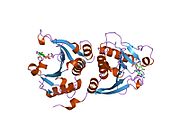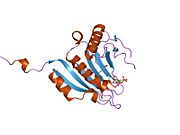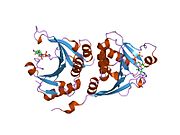EIF4E: Difference between revisions
→Function: What necessarily is it blocking? |
|||
| Line 4: | Line 4: | ||
== Function == |
== Function == |
||
All [[eukaryote|eukaryotic]] cellular [[Messenger RNA|mRNA]]s are |
All [[eukaryote|eukaryotic]] cellular [[Messenger RNA|mRNA]]s are modified at their [[Five prime untranslated region|5-prime]] ends with the 7-methyl-[[guanosine]] cap structure, m7GpppX (where X is any nucleotide). This structure is involved in several cellular processes including enhanced translational efficiency, splicing, mRNA stability, and RNA nuclear export. EIF4E is a eukaryotic translation initiation factor involved in directing [[ribosome]]s to the cap structure of mRNAs. It is a 24-kD polypeptide that exists as both a free form and as part of a multiprotein complex termed EIF4F. The EIF4E polypeptide is the rate-limiting component of the eukaryotic translation apparatus and is involved in the mRNA-ribosome binding step of eukaryotic protein synthesis. The other subunits of EIF4F are a 50-kD polypeptide, termed [[Eif4a|EIF4A]], that possesses [[ATPase]] and RNA [[helicase]] activities, and a 220-kD polypeptide, [[EIF4G]].<ref name="pmid3469651">{{cite journal | author = Rychlik W, Domier LL, Gardner PR, Hellmann GM, Rhoads RE | title = Amino acid sequence of the mRNA cap-binding protein from human tissues | journal = Proc. Natl. Acad. Sci. U.S.A. | volume = 84 | issue = 4 | pages = 945–9 | year = 1987 | month = February | pmid = 3469651 | pmc = 304336 | doi = 10.1073/pnas.84.4.945| url = http://www.pnas.org/cgi/pmidlookup?view=long&pmid=3469651 }}</ref><ref name="entrez">{{cite web | title = Entrez Gene: eIF4E Eukaryotic translation initiation factor 4E | url = http://www.ncbi.nlm.nih.gov/sites/entrez?Db=gene&Cmd=ShowDetailView&TermToSearch=1977| accessdate = }}</ref> |
||
eIF4E's function is to bind an mRNA cap and ultimately bring it to the ribosome. eIF4E is part of the eIF4F pre-initiation complex; which is made up of eIF4E, and eIF4G (eIF4F is sometimes considered to have additional protein components). Almost all cellular proteins require eIF4E in order to be translated into protein. eIF4E binds the first nucleotide on the 5' end of an mRNA molecule (known as the cap): a 7 methyl guanosine (m7G). It sandwiches m7G between 2 tryptophan residues, and other amino acids are involved in the binding. |
eIF4E's function is to bind an mRNA cap and ultimately bring it to the ribosome. eIF4E is part of the eIF4F pre-initiation complex; which is made up of eIF4E, and eIF4G (eIF4F is sometimes considered to have additional protein components). Almost all cellular proteins require eIF4E in order to be translated into protein. eIF4E binds the first nucleotide on the 5' end of an mRNA molecule (known as the cap): a 7 methyl guanosine (m7G). It sandwiches m7G between 2 tryptophan residues, and other amino acids are involved in the binding. |
||
Revision as of 14:00, 12 November 2011
Template:PBB Eukaryotic translation initiation factor 4E, also known as eIF4E, is a protein which in humans is encoded by the eIF4E gene.[1][2]
Function
All eukaryotic cellular mRNAs are modified at their 5-prime ends with the 7-methyl-guanosine cap structure, m7GpppX (where X is any nucleotide). This structure is involved in several cellular processes including enhanced translational efficiency, splicing, mRNA stability, and RNA nuclear export. EIF4E is a eukaryotic translation initiation factor involved in directing ribosomes to the cap structure of mRNAs. It is a 24-kD polypeptide that exists as both a free form and as part of a multiprotein complex termed EIF4F. The EIF4E polypeptide is the rate-limiting component of the eukaryotic translation apparatus and is involved in the mRNA-ribosome binding step of eukaryotic protein synthesis. The other subunits of EIF4F are a 50-kD polypeptide, termed EIF4A, that possesses ATPase and RNA helicase activities, and a 220-kD polypeptide, EIF4G.[3][4]
eIF4E's function is to bind an mRNA cap and ultimately bring it to the ribosome. eIF4E is part of the eIF4F pre-initiation complex; which is made up of eIF4E, and eIF4G (eIF4F is sometimes considered to have additional protein components). Almost all cellular proteins require eIF4E in order to be translated into protein. eIF4E binds the first nucleotide on the 5' end of an mRNA molecule (known as the cap): a 7 methyl guanosine (m7G). It sandwiches m7G between 2 tryptophan residues, and other amino acids are involved in the binding.
Some viruses cut eIF4G in such a way that the eIF4E binding site is removed and the virus is able to translate its proteins without eIF4E. Also some cellular proteins, most notably heat shock proteins, don't require eIF4E in order to be translated. Both viruses and cellular proteins achieve this through an IRES structure in the RNA.
Interactions
EIF4E has been shown to interact with EIF4A1,[5][6] EIF4EBP3,[7][8] EIF4EBP1,[5][6][9][10][11][12][13][14][15][16][17][18][19] EIF4EBP2,[10][20] Eukaryotic translation initiation factor 4 gamma,[6][10][15][21][22] EIF4G2[23] and EIF4ENIF1.[24]
See also
References
- ^ Pelletier J, Brook JD, Housman DE (1991). "Assignment of two of the translation initiation factor-4E (EIF4EL1 and EIF4EL2) genes to human chromosomes 4 and 20". Genomics. 10 (4): 1079–82. doi:10.1016/0888-7543(91)90203-Q. PMID 1916814.
{{cite journal}}: Unknown parameter|month=ignored (help)CS1 maint: multiple names: authors list (link) - ^ Jones RM, MacDonald ME, Branda J, Altherr MR, Louis DN, Schmidt EV (1997). "Assignment of the human gene encoding eukaryotic initiation factor 4E (EIF4E) to the region q21-25 on chromosome 4". Somat. Cell Mol. Genet. 23 (3): 221–3. doi:10.1007/BF02721373. PMID 9330633.
{{cite journal}}: Unknown parameter|month=ignored (help)CS1 maint: multiple names: authors list (link) - ^ Rychlik W, Domier LL, Gardner PR, Hellmann GM, Rhoads RE (1987). "Amino acid sequence of the mRNA cap-binding protein from human tissues". Proc. Natl. Acad. Sci. U.S.A. 84 (4): 945–9. doi:10.1073/pnas.84.4.945. PMC 304336. PMID 3469651.
{{cite journal}}: Unknown parameter|month=ignored (help)CS1 maint: multiple names: authors list (link) - ^ "Entrez Gene: eIF4E Eukaryotic translation initiation factor 4E".
- ^ a b Ewing, Rob M (2007). "Large-scale mapping of human protein-protein interactions by mass spectrometry". Mol. Syst. Biol. 3 (1). England: 89. doi:10.1038/msb4100134. PMC 1847948. PMID 17353931.
{{cite journal}}: Check date values in:|year=(help); Cite has empty unknown parameters:|laydate=,|laysummary=,|month=, and|laysource=(help); Unknown parameter|coauthors=ignored (|author=suggested) (help)CS1 maint: year (link) - ^ a b c Connolly, Eileen (2006). "Hypoxia inhibits protein synthesis through a 4E-BP1 and elongation factor 2 kinase pathway controlled by mTOR and uncoupled in breast cancer cells". Mol. Cell. Biol. 26 (10). United States: 3955–65. doi:10.1128/MCB.26.10.3955-3965.2006. ISSN 0270-7306. PMC 1489005. PMID 16648488.
{{cite journal}}: Check date values in:|year=(help); Cite has empty unknown parameters:|laydate=,|laysummary=, and|laysource=(help); Unknown parameter|coauthors=ignored (|author=suggested) (help); Unknown parameter|month=ignored (help)CS1 maint: year (link) - ^ Kleijn, Miranda (2002). "Localisation and regulation of the eIF4E-binding protein 4E-BP3". FEBS Lett. 532 (3). Netherlands: 319–23. doi:10.1016/S0014-5793(02)03694-3. ISSN 0014-5793. PMID 12482586.
{{cite journal}}: Check date values in:|year=(help); Cite has empty unknown parameters:|laydate=,|laysummary=, and|laysource=(help); Unknown parameter|coauthors=ignored (|author=suggested) (help); Unknown parameter|month=ignored (help)CS1 maint: year (link) - ^ Poulin, F (1998). "4E-BP3, a new member of the eukaryotic initiation factor 4E-binding protein family". J. Biol. Chem. 273 (22). UNITED STATES: 14002–7. doi:10.1074/jbc.273.22.14002. ISSN 0021-9258. PMID 9593750.
{{cite journal}}: Check date values in:|year=(help); Cite has empty unknown parameters:|laydate=,|laysummary=, and|laysource=(help); Unknown parameter|coauthors=ignored (|author=suggested) (help); Unknown parameter|month=ignored (help)CS1 maint: unflagged free DOI (link) CS1 maint: year (link) - ^ Rual, Jean-François (2005). "Towards a proteome-scale map of the human protein-protein interaction network". Nature. 437 (7062). England: 1173–8. doi:10.1038/nature04209. PMID 16189514.
{{cite journal}}: Check date values in:|year=(help); Cite has empty unknown parameters:|laydate=,|laysummary=, and|laysource=(help); Unknown parameter|coauthors=ignored (|author=suggested) (help); Unknown parameter|month=ignored (help)CS1 maint: year (link) - ^ a b c Mader, S (1995). "The translation initiation factor eIF-4E binds to a common motif shared by the translation factor eIF-4 gamma and the translational repressors 4E-binding proteins". Mol. Cell. Biol. 15 (9). UNITED STATES: 4990–7. ISSN 0270-7306. PMC 230746. PMID 7651417.
{{cite journal}}: Check date values in:|year=(help); Cite has empty unknown parameters:|laydate=,|laysummary=, and|laysource=(help); Unknown parameter|coauthors=ignored (|author=suggested) (help); Unknown parameter|month=ignored (help)CS1 maint: year (link) - ^ Rao, Ravi D (2005). "Disruption of parallel and converging signaling pathways contributes to the synergistic antitumor effects of simultaneous mTOR and EGFR inhibition in GBM cells". Neoplasia. 7 (10). United States: 921–9. doi:10.1593/neo.05361. ISSN 1522-8002. PMC 1502028. PMID 16242075.
{{cite journal}}: Check date values in:|year=(help); Cite has empty unknown parameters:|laydate=,|laysummary=, and|laysource=(help); Unknown parameter|coauthors=ignored (|author=suggested) (help); Unknown parameter|month=ignored (help)CS1 maint: year (link) - ^ Eguchi, Satoshi (2006). "Different roles for the TOS and RAIP motifs of the translational regulator protein 4E-BP1 in the association with raptor and phosphorylation by mTOR in the regulation of cell size". Genes Cells. 11 (7). England: 757–66. doi:10.1111/j.1365-2443.2006.00977.x. ISSN 1356-9597. PMID 16824195.
{{cite journal}}: Check date values in:|year=(help); Cite has empty unknown parameters:|laydate=,|laysummary=, and|laysource=(help); Unknown parameter|coauthors=ignored (|author=suggested) (help); Unknown parameter|month=ignored (help)CS1 maint: year (link) - ^ Yang, D (1999). "Mutational analysis of sites in the translational regulator, PHAS-I, that are selectively phosphorylated by mTOR". FEBS Lett. 453 (3). NETHERLANDS: 387–90. doi:10.1016/S0014-5793(99)00762-0. ISSN 0014-5793. PMID 10405182.
{{cite journal}}: Check date values in:|year=(help); Cite has empty unknown parameters:|laydate=,|laysummary=, and|laysource=(help); Unknown parameter|coauthors=ignored (|author=suggested) (help); Unknown parameter|month=ignored (help)CS1 maint: year (link) - ^ Patel, Jashmin (2002). "Cellular stresses profoundly inhibit protein synthesis and modulate the states of phosphorylation of multiple translation factors". Eur. J. Biochem. 269 (12). Germany: 3076–85. doi:10.1046/j.1432-1033.2002.02992.x. ISSN 0014-2956. PMID 12071973.
{{cite journal}}: Check date values in:|year=(help); Cite has empty unknown parameters:|laydate=,|laysummary=, and|laysource=(help); Unknown parameter|coauthors=ignored (|author=suggested) (help); Unknown parameter|month=ignored (help)CS1 maint: year (link) - ^ a b Kumar, V (2000). "Regulation of the rapamycin and FKBP-target 1/mammalian target of rapamycin and cap-dependent initiation of translation by the c-Abl protein-tyrosine kinase". J. Biol. Chem. 275 (15). UNITED STATES: 10779–87. doi:10.1074/jbc.275.15.10779. ISSN 0021-9258. PMID 10753870.
{{cite journal}}: Check date values in:|year=(help); Cite has empty unknown parameters:|laydate=,|laysummary=, and|laysource=(help); Unknown parameter|coauthors=ignored (|author=suggested) (help); Unknown parameter|month=ignored (help)CS1 maint: unflagged free DOI (link) CS1 maint: year (link) - ^ Kumar, V (2000). "Functional interaction between RAFT1/FRAP/mTOR and protein kinase cdelta in the regulation of cap-dependent initiation of translation". EMBO J. 19 (5). ENGLAND: 1087–97. doi:10.1093/emboj/19.5.1087. ISSN 0261-4189. PMC 305647. PMID 10698949.
{{cite journal}}: Check date values in:|year=(help); Cite has empty unknown parameters:|laydate=,|laysummary=, and|laysource=(help); Unknown parameter|coauthors=ignored (|author=suggested) (help); Unknown parameter|month=ignored (help)CS1 maint: year (link) - ^ Gingras, A C (1999). "Regulation of 4E-BP1 phosphorylation: a novel two-step mechanism". Genes Dev. 13 (11). UNITED STATES: 1422–37. doi:10.1101/gad.13.11.1422. ISSN 0890-9369. PMC 316780. PMID 10364159.
{{cite journal}}: Check date values in:|year=(help); Cite has empty unknown parameters:|laydate=,|laysummary=, and|laysource=(help); Unknown parameter|coauthors=ignored (|author=suggested) (help); Unknown parameter|month=ignored (help)CS1 maint: year (link) - ^ Shen, X (2001). "Structural and thermodynamic behavior of eukaryotic initiation factor 4E in supramolecular formation with 4E-binding protein 1 and mRNA cap analogue, studied by spectroscopic methods". Chem. Pharm. Bull. 49 (10). Japan: 1299–303. doi:10.1248/cpb.49.1299. ISSN 0009-2363. PMID 11605658.
{{cite journal}}: Check date values in:|year=(help); Cite has empty unknown parameters:|laydate=,|laysummary=, and|laysource=(help); Unknown parameter|coauthors=ignored (|author=suggested) (help); Unknown parameter|month=ignored (help)CS1 maint: year (link) - ^ Adegoke, Olasunkanmi A J (2009). "Fed-state clamp stimulates cellular mechanisms of muscle protein anabolism and modulates glucose disposal in normal men". Am. J. Physiol. Endocrinol. Metab. 296 (1). United States: E105–13. doi:10.1152/ajpendo.90752.2008. ISSN 0193-1849. PMC 2636991. PMID 18957614.
{{cite journal}}: Check date values in:|year=(help); Cite has empty unknown parameters:|laydate=,|laysummary=, and|laysource=(help); Unknown parameter|coauthors=ignored (|author=suggested) (help); Unknown parameter|month=ignored (help)CS1 maint: year (link) - ^ Pause, A (1994). "Insulin-dependent stimulation of protein synthesis by phosphorylation of a regulator of 5'-cap function". Nature. 371 (6500). ENGLAND: 762–7. doi:10.1038/371762a0. ISSN 0028-0836. PMID 7935836.
{{cite journal}}: Check date values in:|year=(help); Cite has empty unknown parameters:|laydate=,|laysummary=, and|laysource=(help); Unknown parameter|coauthors=ignored (|author=suggested) (help); Unknown parameter|month=ignored (help); Unknown parameter|unused_data=ignored (help)CS1 maint: year (link) - ^ Vary, T C (1999). "Amino acid-induced stimulation of translation initiation in rat skeletal muscle". Am. J. Physiol. 277 (6 Pt 1). UNITED STATES: E1077–86. ISSN 0002-9513. PMID 10600798.
{{cite journal}}: Check date values in:|year=(help); Cite has empty unknown parameters:|laydate=,|laysummary=, and|laysource=(help); Unknown parameter|coauthors=ignored (|author=suggested) (help); Unknown parameter|month=ignored (help)CS1 maint: year (link) - ^ Harris, Thurl E (2006). "mTOR-dependent stimulation of the association of eIF4G and eIF3 by insulin". EMBO J. 25 (8). England: 1659–68. doi:10.1038/sj.emboj.7601047. ISSN 0261-4189. PMC 1440840. PMID 16541103.
{{cite journal}}: Check date values in:|year=(help); Cite has empty unknown parameters:|laydate=,|laysummary=, and|laysource=(help); Unknown parameter|coauthors=ignored (|author=suggested) (help); Unknown parameter|month=ignored (help)CS1 maint: year (link) - ^ Gradi, A (1998). "A novel functional human eukaryotic translation initiation factor 4G". Mol. Cell. Biol. 18 (1). UNITED STATES: 334–42. ISSN 0270-7306. PMC 121501. PMID 9418880.
{{cite journal}}: Check date values in:|year=(help); Cite has empty unknown parameters:|laydate=,|laysummary=, and|laysource=(help); Unknown parameter|coauthors=ignored (|author=suggested) (help); Unknown parameter|month=ignored (help)CS1 maint: year (link) - ^ Dostie, J (2000). "A novel shuttling protein, 4E-T, mediates the nuclear import of the mRNA 5' cap-binding protein, eIF4E". EMBO J. 19 (12). ENGLAND: 3142–56. doi:10.1093/emboj/19.12.3142. ISSN 0261-4189. PMC 203362. PMID 10856257.
{{cite journal}}: Check date values in:|year=(help); Cite has empty unknown parameters:|laydate=,|laysummary=, and|laysource=(help); Unknown parameter|coauthors=ignored (|author=suggested) (help); Unknown parameter|month=ignored (help)CS1 maint: year (link)
External links
- Cap-dependent translation initiation from Nature Reviews Microbiology. A good image and overview of the function of initiation factors
Further reading
This article incorporates text from the United States National Library of Medicine, which is in the public domain.








